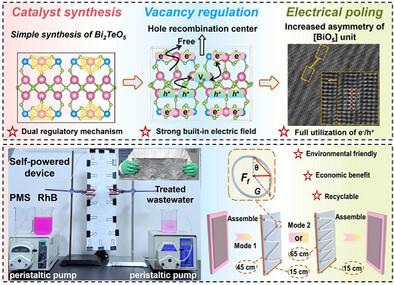Oxygen Vacancies and Electric Poling Synergistically Modulate c-Axis Built-in Electric Field in Bi2TeO5 for Efficient H2O2 Production under Real Water Motion
IF 19
1区 材料科学
Q1 CHEMISTRY, MULTIDISCIPLINARY
引用次数: 0
Abstract
Conventional Bi2TeO5 (BTO) synthesis requires high energy consumption and impurity phases. Additionally, polarization disorder in [BiO5] units and weak interlayer coupling limit charge transport efficiency. To address these issues, a facile hydrothermal method for pure-phase BTO synthesis is developed. A synergistic strategy combining oxygen vacancy introduction and electric poling (P-BTO-VO) created highly ordered c-axis-aligned built-in electric fields (IEF). Oxygen vacancies are shown to break [BiO5] symmetry, forming donor levels as hole-trapping centers and generating c-axis-aligned IEF for improved charge separation. Electric poling increases interlayer potential difference from 0 to 0.12 eV and reduces interlayer spacing by 0.1 Å, synergistically enhancing the IEF. This dual modulation also adjusts the Bi site electronic charge (by +1.04 eV) and shifts the d-band center (by −0.97 eV), boosting water adsorption. P-BTO-VO shows 2.7, 2.0, 6.1, and 1.2-fold improvements in polarization strength, piezoelectric coefficient, surface charge density, and carrier mobility versus BTO. The P-BTO-VO material showed some further inherent advantages, like achieving a 256 µmol g−1 h−1 H2O2 yield in pure water flow and an efficient activation of peroxymonosulfate to degrade a number of pollutants. A self-driven water treatment reactor using P-BTO-VO/PVDF membranes can demonstrate practical scalability, establishing a “defect regulation-electric poling-scalable application” paradigm for designing piezo-catalysts.

氧空位和电极化协同调节Bi2TeO5的c轴内置电场,以实现真实水运动下的高效H2O2生产
传统的Bi2TeO5 (BTO)合成需要高能量消耗和杂质相。此外,[BiO5]单元的极化紊乱和弱层间耦合限制了电荷输运效率。为了解决这些问题,开发了一种简便的水热法合成纯相BTO。结合氧空位引入和电极化(P-BTO-VO)的协同策略创建了高度有序的c轴对齐内置电场(IEF)。氧空位打破了[BiO5]的对称性,形成了供体能级作为空穴捕获中心,并产生了c轴对齐的IEF,以改善电荷分离。电极化使层间电位差从0增加到0.12 eV,层间间距减少0.1 Å,协同增强了IEF。这种双调制还调节了Bi位点的电子电荷(+1.04 eV),并使d带中心偏移(- 0.97 eV),促进了水的吸附。与BTO相比,P-BTO-VO在极化强度、压电系数、表面电荷密度和载流子迁移率方面分别提高了2.7倍、2.0倍、6.1倍和1.2倍。P-BTO-VO材料显示出一些固有的优势,如在纯水中实现256µmol g−1 h−1 H2O2产率,并有效激活过氧单硫酸盐以降解多种污染物。使用P-BTO-VO/PVDF膜的自驱动水处理反应器可以展示实际的可扩展性,为设计压电催化剂建立了“缺陷调节-电极化-可扩展应用”的范例。
本文章由计算机程序翻译,如有差异,请以英文原文为准。
求助全文
约1分钟内获得全文
求助全文
来源期刊

Advanced Functional Materials
工程技术-材料科学:综合
CiteScore
29.50
自引率
4.20%
发文量
2086
审稿时长
2.1 months
期刊介绍:
Firmly established as a top-tier materials science journal, Advanced Functional Materials reports breakthrough research in all aspects of materials science, including nanotechnology, chemistry, physics, and biology every week.
Advanced Functional Materials is known for its rapid and fair peer review, quality content, and high impact, making it the first choice of the international materials science community.
 求助内容:
求助内容: 应助结果提醒方式:
应助结果提醒方式:


